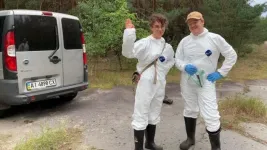(Press-News.org) CORVALLIS, Ore. – Scientists led by an Oregon State University chemistry researcher are closing in on a new tool for tackling the global problem of weedkiller-tainted groundwater.
Kyriakos Stylianou of the OSU College of Science led an international team that identified a material known as a metal-organic framework, or MOF, that showed an ability to completely remove, and also break down, the oft-used herbicide glyphosate.
The MOF, one of four tested in a collaboration among scientists from Oregon State and Tiangong University in China, is based on scandium, chemical symbol Sc, and a carboxylate linker, TBAPy.
“When exposed to light for just five minutes, Sc-TBAPy eliminated 100% of glyphosate in water,” Stylianou said. “In addition to its quicker adsorption and more efficient photodegradation of glyphosate compared to the other three TBAPy MOFs we looked at, it also degraded the glyphosate without producing a toxic acid, unlike the other three.”
Findings were published in Nature Communications.
The MOFs in this experiment rely on photocatalysis. A catalyst is a substance that increases the rate of a chemical reaction without itself undergoing any permanent chemical change, and photocatalysts are materials that absorb light to reach a higher energy level and can use that energy to break down organic contaminants through oxidation.
Among photocatalysts’ many applications are self-cleaning coatings for stain- and odor-resistant walls, floors, ceilings and furniture.
Made up of positively charged metal ions surrounded by organic linker molecules, MOFs are crystalline, porous materials with tunable structural properties and nanosized pores. They can be designed with a variety of components that determine the MOF’s properties.
Glyphosate, also known as N-phosphonomethyl glycine or PMG, has been widely sprayed on agricultural fields over the last 50 years since first appearing on the market under the trade name Roundup.
“Glyphosate and other herbicides are commonly used to safeguard farms from weed infestations, but the persistence of glyphosate in the environment has been associated with potential health effects on various living organisms including humans,” Stylianou said. “Only a small percentage of the total amount of PMG applied is taken up by crops, and herbicides leaching into water channels are a primary cause of water pollution. That means it’s crucial to come up with innovative technologies and materials to combat this problem.”
To uncover the PMG remediation abilities of Sc-TBAPy, Stylianou’s lab collaborated with groups led by Chong Fang, Paul Ha Yeon Cheong and Hongliang Huang at Tiangong University. Stylianou said his collaborators provided key insights into the MOF’s adsorption properties and photocatalytic activity.
A number of Oregon State graduate students also played important roles in the study, Stylianou said. Nan Chieh Chiu, Jacob Lessard and Emmanuel Musa led all the experiments and catalysis testing, Logan Lancaster investigated the optical properties of the materials being researched, and Clara Wheeler computationally examined their electronic properties.
OSU postdoctoral researcher Taylor Krueger, research associate Cheng Chen and graduate students Trenton Gallagher and Makenzie Nord also took part in the study.
The National Science Foundation, the Oregon State University College of Science and the OSU Department of Chemistry funded this research.
END
Oregon State researchers make key advance toward removing pesticide from groundwater
2024-03-06
ELSE PRESS RELEASES FROM THIS DATE:
UTEP clinical trial to encourage healthy walking habits
2024-03-06
EL PASO, Texas (March 5, 2024) – Health researchers at The University of Texas at El Paso are launching a clinical trial to improve walking in the El Paso community, thanks to a $4.4 million grant from the National Institutes of Health (NIH). The project will enroll local school district employees in 50K 4 Life, a program that challenges them to improve their health by walking at least 50,000 steps per week.
“This is an exciting opportunity to improve our community’s health through the simple, free and life-changing ...
Research explores the cooling effects of ‘scuba-diving’ in lizards
2024-03-06
BINGHAMTON, N.Y. -- Anoles are the scuba-diving champions of the lizard world, able to stay underwater for more than 16 minutes. For animals whose body temperature depends on the environment, time spent in a cool running stream can have some tradeoffs, according to new research from Binghamton University, State University of New York.
A recent study by Binghamton University doctoral candidate Alexandra M. Martin, Christopher K. Boccia of Queens University in Canada, and Binghamton University Assistant Research Professor of Biological Sciences Lindsey ...
Gender gap on Wikipedia
2024-03-05
Since it was created in 2001, Wikipedia has become a key element of the modern public sphere, which has revolutionized the way we create and share information. However, it has defects when it comes to its decentralization and flexibility, specially regarding inclusion and diversity.
Some gender biases that stand out are shown in its content and its editorial participation. It has a low percentage of women’s biographies and an unequal representation in editing. Also, there are gaps in the gender representation regarding its content, biases in editing and participation, as well as imbalances in readership.
These ...
Scientists to study real-world eating behaviors using wearable sensors and artificial intelligence
2024-03-05
A pedometer measures your steps, but what if you had a similar automated device to measure your eating behavior? Evidence from nutritional studies has long shown that the speed, timing and duration of an individual’s eating behavior are strongly related to obesity and other health issues. While eating behaviors can be accurately measured in a controlled laboratory setting, a blind spot exists when researchers attempt to study how participants actually eat “in the wild.”
A new National Institutes ...
Radioguided surgery accurately detects and removes metastatic lymph nodes in newly diagnosed prostate cancer patients
2024-03-05
Reston, VA — Radioguided surgery can detect and remove metastatic pelvic lymph nodes in patients newly diagnosed with prostate cancer, according to research published in the March issue of The Journal of Nuclear Medicine. Targeting the prostate-specific membrane antigen (PSMA), which is overexpressed in most prostate cancer patients, radioguided surgery can improve nodal staging to guide treatment recommendations for this important patient population.
In newly diagnosed prostate cancer patients, nodal involvement correlates with recurrence, and determining if lymph node metastases are present and where they ...
Aluminum nanoparticles make tunable green catalysts
2024-03-05
HOUSTON – (March 5, 2024) – Catalysts unlock pathways for chemical reactions to unfold at faster and more efficient rates, and the development of new catalytic technologies is a critical part of the green energy transition.
The Rice University lab of nanotechnology pioneer Naomi Halas has uncovered a transformative approach to harnessing the catalytic power of aluminum nanoparticles by annealing them in various gas atmospheres at high temperatures.
According to a study published in the Proceedings of the National Academy of Sciences, Rice ...
Electrolyte cation types control electrochemical reactions on an electrode surface
2024-03-05
1. An international research group consisting of NIMS and the Finnish University of Jyväskylä has discovered through its electrode-electrolyte system research that electron and proton (i.e., hydrogen ion) transfer mechanisms during oxygen reduction reactions (ORRs) on electrode surfaces vary depending on the types of cations dissolved in the electrolytic solution. These results suggest that the energy conversion efficiencies and selectivity of electrochemical systems (e.g., fuel cells and water electrolysis hydrogen production systems) can be improved by selecting optimal reaction pathways and that this could be achieved without using expensive electrode ...
The dangers of misaligned product co-development contracts—and how they can derail innovation in high-tech firms
2024-03-05
Researchers from Mansoura University and University of Guelph published a new Journal of Marketing study that examines how misaligned contracts can erode innovation outcomes of high-tech firms.
The study, forthcoming in the Journal of Marketing, is titled “Collaborating to Innovate: Balancing Strategy Dividend and Transactional Efficiencies” and is authored by Nehal Elhelaly and Sourav Ray.
When a giant multinational like Unilever partners with one of its major suppliers, such as the industrial enzyme-producer Novozyme, the collaboration can fast-track ...
New publication highlights urgency of parasitic wasp release to save native bird
2024-03-05
DENVER/March 5, 2024 – Researchers with the University of Minnesota, funded by Morris Animal Foundation, hope to release highly-specialized parasitic wasps to serve as a biological control method to save Darwin’s finches from a dire threat: the invasive avian vampire fly, Philornis downsi.
This species has been devastating finch populations on the Galapagos Islands by laying eggs in their nests, with the emerging larvae harming the nestlings.
To protect these iconic birds and other endemic species impacted by the fly, ...
Tiny worms tolerate chornobyl radiation
2024-03-05
The 1986 disaster at the Chornobyl nuclear power plant transformed the surrounding area into the most radioactive landscape on Earth. Humans were evacuated, but many plants and animals continue to live in the region, despite the high levels of radiation that persist nearly four decades later.
A new study led by researchers at New York University finds that exposure to chronic radiation from Chornobyl has not damaged the genomes of microscopic worms living there today—which doesn’t mean that the region is safe, the scientists caution, but suggests that these worms are exceptionally resilient.
In ...








